Report on Physiological Principles for Health and Social Care
VerifiedAdded on 2020/06/05
|12
|3813
|167
Report
AI Summary
This report provides a comprehensive overview of physiological principles relevant to health and social care. It begins by examining the structure and function of the human body, detailing the important anatomical features and the interactions between various body systems, such as the digestive, circulatory, immune, endocrine, nervous, reproductive, muscular, respiratory, and integumentary systems. The report then explores the relationship between body functioning, physiology, and anatomy, including normal body responses to everyday activities and the cellular and tissue structures that explain these responses. It also delves into how the body coordinates its internal activities through various systems like the nervous, circulatory, lymphatic, endocrine, and respiratory systems. Furthermore, the report discusses the significance of routine data collected in health and social care, including how such data informs the planning of care for individuals and how variations in body structure and functioning relate to the care received, considering the effects of age and common disorders. The report concludes by relating the effects of common disorders and infections to the care routinely given to affected individuals, providing a well-rounded understanding of the subject matter.
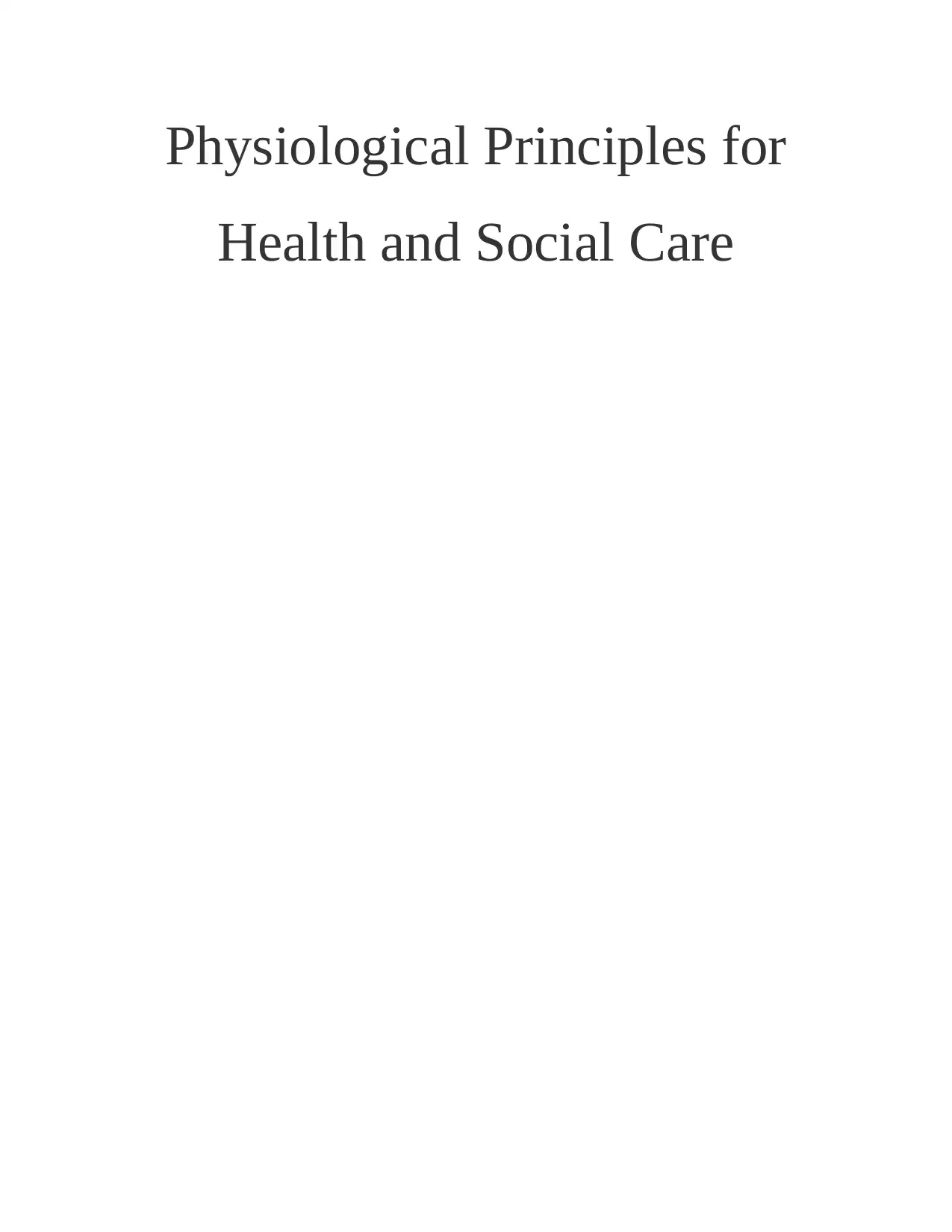
Physiological Principles for
Health and Social Care
Health and Social Care
Paraphrase This Document
Need a fresh take? Get an instant paraphrase of this document with our AI Paraphraser
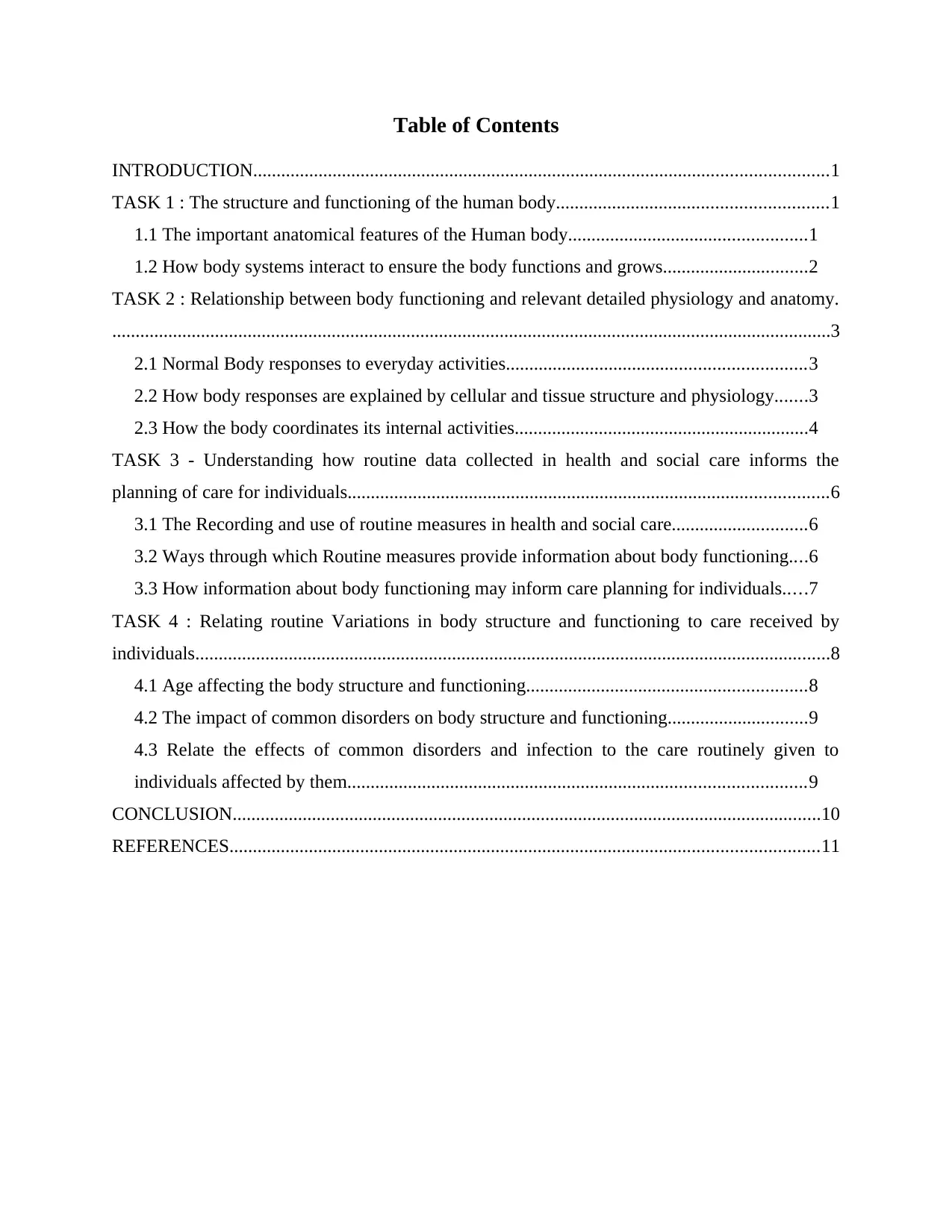
Table of Contents
INTRODUCTION...........................................................................................................................1
TASK 1 : The structure and functioning of the human body..........................................................1
1.1 The important anatomical features of the Human body...................................................1
1.2 How body systems interact to ensure the body functions and grows...............................2
TASK 2 : Relationship between body functioning and relevant detailed physiology and anatomy.
..........................................................................................................................................................3
2.1 Normal Body responses to everyday activities................................................................3
2.2 How body responses are explained by cellular and tissue structure and physiology.......3
2.3 How the body coordinates its internal activities...............................................................4
TASK 3 - Understanding how routine data collected in health and social care informs the
planning of care for individuals.......................................................................................................6
3.1 The Recording and use of routine measures in health and social care.............................6
3.2 Ways through which Routine measures provide information about body functioning....6
3.3 How information about body functioning may inform care planning for individuals.....7
TASK 4 : Relating routine Variations in body structure and functioning to care received by
individuals........................................................................................................................................8
4.1 Age affecting the body structure and functioning............................................................8
4.2 The impact of common disorders on body structure and functioning..............................9
4.3 Relate the effects of common disorders and infection to the care routinely given to
individuals affected by them..................................................................................................9
CONCLUSION..............................................................................................................................10
REFERENCES..............................................................................................................................11
INTRODUCTION...........................................................................................................................1
TASK 1 : The structure and functioning of the human body..........................................................1
1.1 The important anatomical features of the Human body...................................................1
1.2 How body systems interact to ensure the body functions and grows...............................2
TASK 2 : Relationship between body functioning and relevant detailed physiology and anatomy.
..........................................................................................................................................................3
2.1 Normal Body responses to everyday activities................................................................3
2.2 How body responses are explained by cellular and tissue structure and physiology.......3
2.3 How the body coordinates its internal activities...............................................................4
TASK 3 - Understanding how routine data collected in health and social care informs the
planning of care for individuals.......................................................................................................6
3.1 The Recording and use of routine measures in health and social care.............................6
3.2 Ways through which Routine measures provide information about body functioning....6
3.3 How information about body functioning may inform care planning for individuals.....7
TASK 4 : Relating routine Variations in body structure and functioning to care received by
individuals........................................................................................................................................8
4.1 Age affecting the body structure and functioning............................................................8
4.2 The impact of common disorders on body structure and functioning..............................9
4.3 Relate the effects of common disorders and infection to the care routinely given to
individuals affected by them..................................................................................................9
CONCLUSION..............................................................................................................................10
REFERENCES..............................................................................................................................11
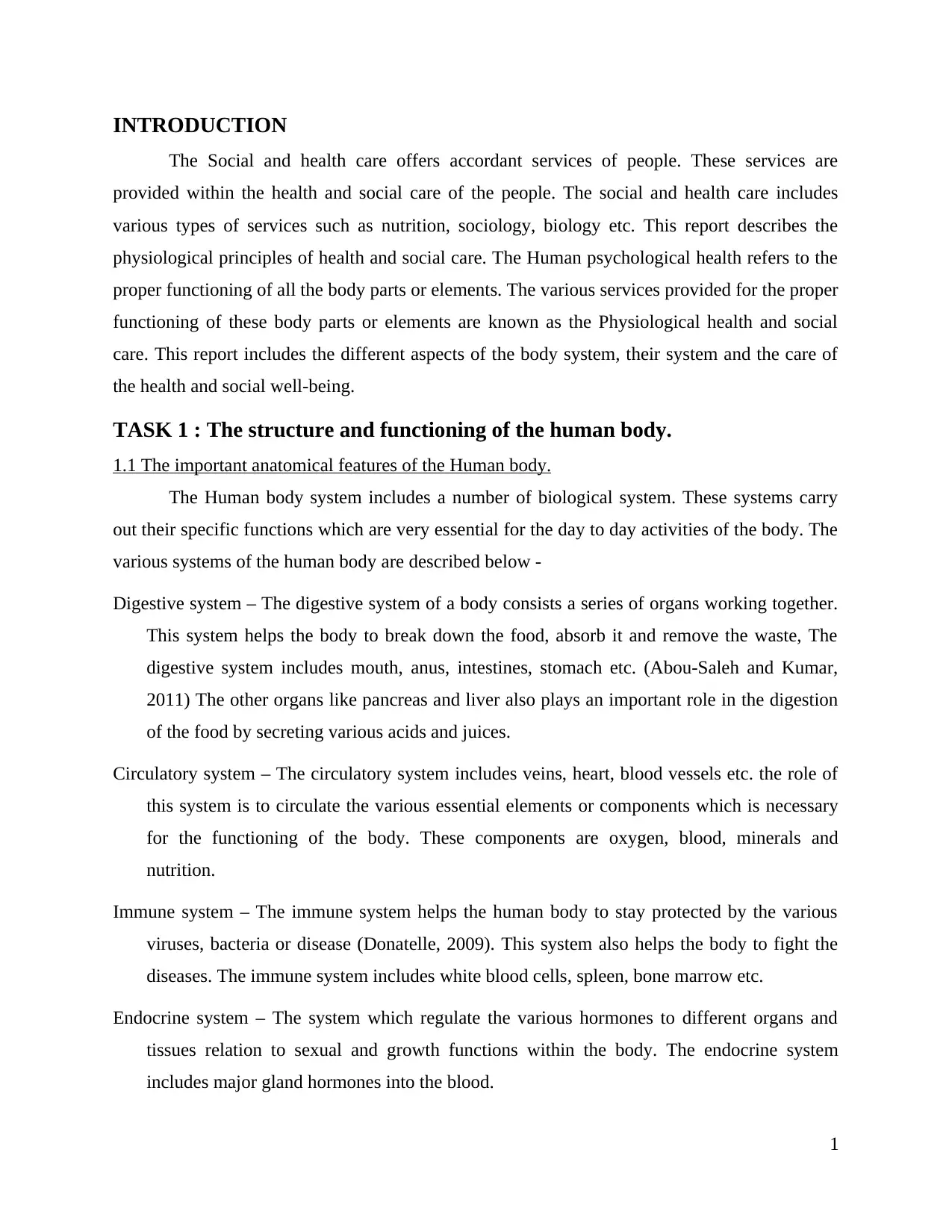
INTRODUCTION
The Social and health care offers accordant services of people. These services are
provided within the health and social care of the people. The social and health care includes
various types of services such as nutrition, sociology, biology etc. This report describes the
physiological principles of health and social care. The Human psychological health refers to the
proper functioning of all the body parts or elements. The various services provided for the proper
functioning of these body parts or elements are known as the Physiological health and social
care. This report includes the different aspects of the body system, their system and the care of
the health and social well-being.
TASK 1 : The structure and functioning of the human body.
1.1 The important anatomical features of the Human body.
The Human body system includes a number of biological system. These systems carry
out their specific functions which are very essential for the day to day activities of the body. The
various systems of the human body are described below -
Digestive system – The digestive system of a body consists a series of organs working together.
This system helps the body to break down the food, absorb it and remove the waste, The
digestive system includes mouth, anus, intestines, stomach etc. (Abou-Saleh and Kumar,
2011) The other organs like pancreas and liver also plays an important role in the digestion
of the food by secreting various acids and juices.
Circulatory system – The circulatory system includes veins, heart, blood vessels etc. the role of
this system is to circulate the various essential elements or components which is necessary
for the functioning of the body. These components are oxygen, blood, minerals and
nutrition.
Immune system – The immune system helps the human body to stay protected by the various
viruses, bacteria or disease (Donatelle, 2009). This system also helps the body to fight the
diseases. The immune system includes white blood cells, spleen, bone marrow etc.
Endocrine system – The system which regulate the various hormones to different organs and
tissues relation to sexual and growth functions within the body. The endocrine system
includes major gland hormones into the blood.
1
The Social and health care offers accordant services of people. These services are
provided within the health and social care of the people. The social and health care includes
various types of services such as nutrition, sociology, biology etc. This report describes the
physiological principles of health and social care. The Human psychological health refers to the
proper functioning of all the body parts or elements. The various services provided for the proper
functioning of these body parts or elements are known as the Physiological health and social
care. This report includes the different aspects of the body system, their system and the care of
the health and social well-being.
TASK 1 : The structure and functioning of the human body.
1.1 The important anatomical features of the Human body.
The Human body system includes a number of biological system. These systems carry
out their specific functions which are very essential for the day to day activities of the body. The
various systems of the human body are described below -
Digestive system – The digestive system of a body consists a series of organs working together.
This system helps the body to break down the food, absorb it and remove the waste, The
digestive system includes mouth, anus, intestines, stomach etc. (Abou-Saleh and Kumar,
2011) The other organs like pancreas and liver also plays an important role in the digestion
of the food by secreting various acids and juices.
Circulatory system – The circulatory system includes veins, heart, blood vessels etc. the role of
this system is to circulate the various essential elements or components which is necessary
for the functioning of the body. These components are oxygen, blood, minerals and
nutrition.
Immune system – The immune system helps the human body to stay protected by the various
viruses, bacteria or disease (Donatelle, 2009). This system also helps the body to fight the
diseases. The immune system includes white blood cells, spleen, bone marrow etc.
Endocrine system – The system which regulate the various hormones to different organs and
tissues relation to sexual and growth functions within the body. The endocrine system
includes major gland hormones into the blood.
1
⊘ This is a preview!⊘
Do you want full access?
Subscribe today to unlock all pages.

Trusted by 1+ million students worldwide
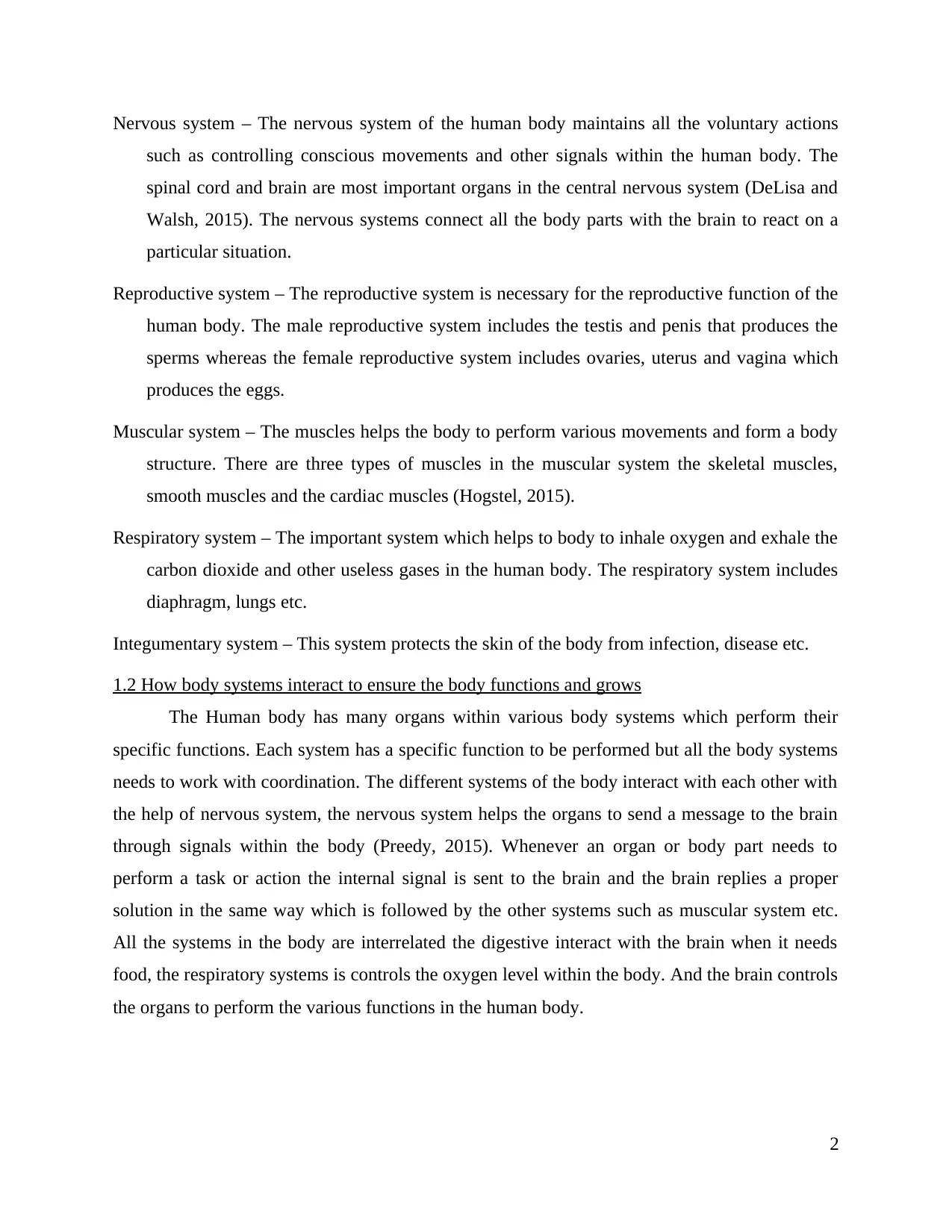
Nervous system – The nervous system of the human body maintains all the voluntary actions
such as controlling conscious movements and other signals within the human body. The
spinal cord and brain are most important organs in the central nervous system (DeLisa and
Walsh, 2015). The nervous systems connect all the body parts with the brain to react on a
particular situation.
Reproductive system – The reproductive system is necessary for the reproductive function of the
human body. The male reproductive system includes the testis and penis that produces the
sperms whereas the female reproductive system includes ovaries, uterus and vagina which
produces the eggs.
Muscular system – The muscles helps the body to perform various movements and form a body
structure. There are three types of muscles in the muscular system the skeletal muscles,
smooth muscles and the cardiac muscles (Hogstel, 2015).
Respiratory system – The important system which helps to body to inhale oxygen and exhale the
carbon dioxide and other useless gases in the human body. The respiratory system includes
diaphragm, lungs etc.
Integumentary system – This system protects the skin of the body from infection, disease etc.
1.2 How body systems interact to ensure the body functions and grows
The Human body has many organs within various body systems which perform their
specific functions. Each system has a specific function to be performed but all the body systems
needs to work with coordination. The different systems of the body interact with each other with
the help of nervous system, the nervous system helps the organs to send a message to the brain
through signals within the body (Preedy, 2015). Whenever an organ or body part needs to
perform a task or action the internal signal is sent to the brain and the brain replies a proper
solution in the same way which is followed by the other systems such as muscular system etc.
All the systems in the body are interrelated the digestive interact with the brain when it needs
food, the respiratory systems is controls the oxygen level within the body. And the brain controls
the organs to perform the various functions in the human body.
2
such as controlling conscious movements and other signals within the human body. The
spinal cord and brain are most important organs in the central nervous system (DeLisa and
Walsh, 2015). The nervous systems connect all the body parts with the brain to react on a
particular situation.
Reproductive system – The reproductive system is necessary for the reproductive function of the
human body. The male reproductive system includes the testis and penis that produces the
sperms whereas the female reproductive system includes ovaries, uterus and vagina which
produces the eggs.
Muscular system – The muscles helps the body to perform various movements and form a body
structure. There are three types of muscles in the muscular system the skeletal muscles,
smooth muscles and the cardiac muscles (Hogstel, 2015).
Respiratory system – The important system which helps to body to inhale oxygen and exhale the
carbon dioxide and other useless gases in the human body. The respiratory system includes
diaphragm, lungs etc.
Integumentary system – This system protects the skin of the body from infection, disease etc.
1.2 How body systems interact to ensure the body functions and grows
The Human body has many organs within various body systems which perform their
specific functions. Each system has a specific function to be performed but all the body systems
needs to work with coordination. The different systems of the body interact with each other with
the help of nervous system, the nervous system helps the organs to send a message to the brain
through signals within the body (Preedy, 2015). Whenever an organ or body part needs to
perform a task or action the internal signal is sent to the brain and the brain replies a proper
solution in the same way which is followed by the other systems such as muscular system etc.
All the systems in the body are interrelated the digestive interact with the brain when it needs
food, the respiratory systems is controls the oxygen level within the body. And the brain controls
the organs to perform the various functions in the human body.
2
Paraphrase This Document
Need a fresh take? Get an instant paraphrase of this document with our AI Paraphraser
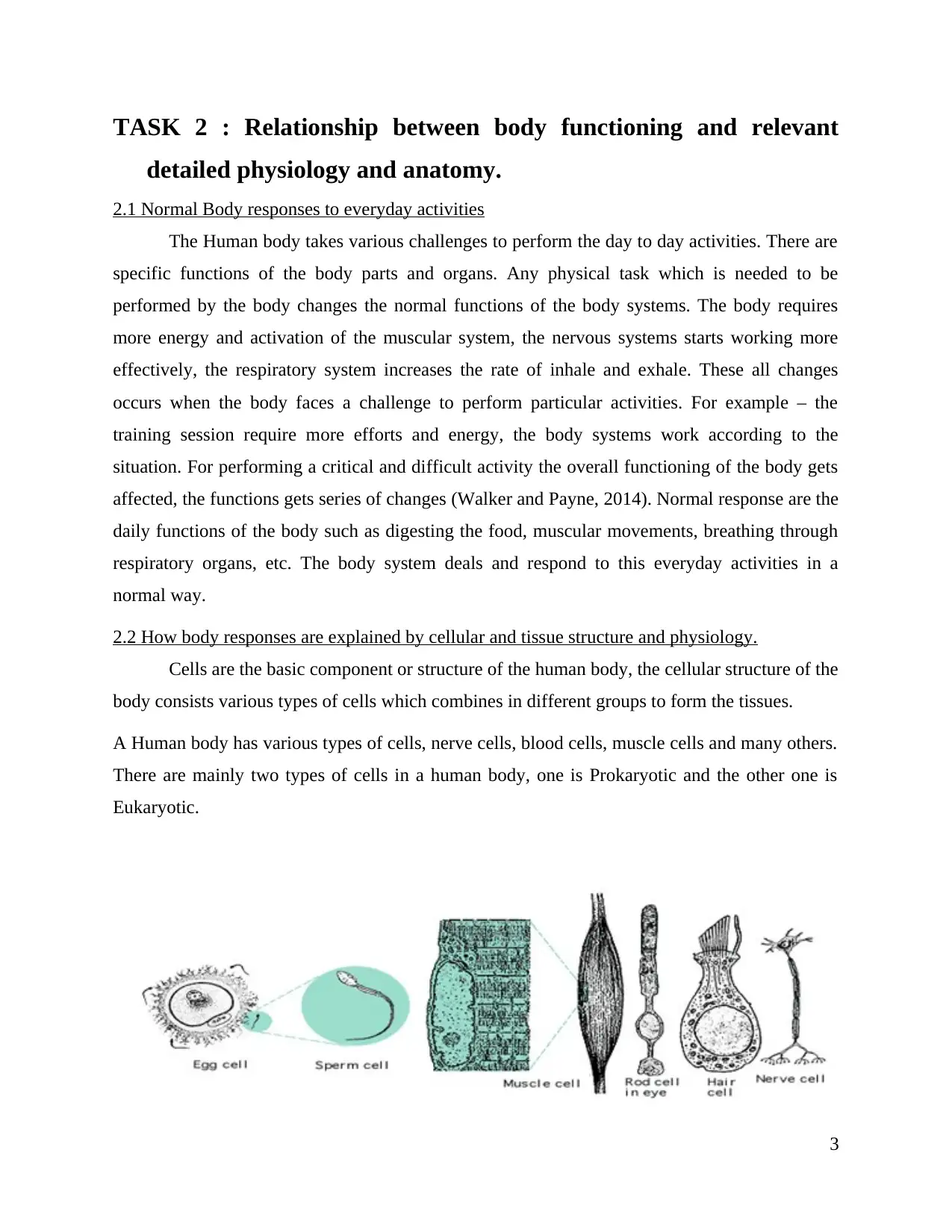
TASK 2 : Relationship between body functioning and relevant
detailed physiology and anatomy.
2.1 Normal Body responses to everyday activities
The Human body takes various challenges to perform the day to day activities. There are
specific functions of the body parts and organs. Any physical task which is needed to be
performed by the body changes the normal functions of the body systems. The body requires
more energy and activation of the muscular system, the nervous systems starts working more
effectively, the respiratory system increases the rate of inhale and exhale. These all changes
occurs when the body faces a challenge to perform particular activities. For example – the
training session require more efforts and energy, the body systems work according to the
situation. For performing a critical and difficult activity the overall functioning of the body gets
affected, the functions gets series of changes (Walker and Payne, 2014). Normal response are the
daily functions of the body such as digesting the food, muscular movements, breathing through
respiratory organs, etc. The body system deals and respond to this everyday activities in a
normal way.
2.2 How body responses are explained by cellular and tissue structure and physiology.
Cells are the basic component or structure of the human body, the cellular structure of the
body consists various types of cells which combines in different groups to form the tissues.
A Human body has various types of cells, nerve cells, blood cells, muscle cells and many others.
There are mainly two types of cells in a human body, one is Prokaryotic and the other one is
Eukaryotic.
3
Illustration 1: Types of cells
detailed physiology and anatomy.
2.1 Normal Body responses to everyday activities
The Human body takes various challenges to perform the day to day activities. There are
specific functions of the body parts and organs. Any physical task which is needed to be
performed by the body changes the normal functions of the body systems. The body requires
more energy and activation of the muscular system, the nervous systems starts working more
effectively, the respiratory system increases the rate of inhale and exhale. These all changes
occurs when the body faces a challenge to perform particular activities. For example – the
training session require more efforts and energy, the body systems work according to the
situation. For performing a critical and difficult activity the overall functioning of the body gets
affected, the functions gets series of changes (Walker and Payne, 2014). Normal response are the
daily functions of the body such as digesting the food, muscular movements, breathing through
respiratory organs, etc. The body system deals and respond to this everyday activities in a
normal way.
2.2 How body responses are explained by cellular and tissue structure and physiology.
Cells are the basic component or structure of the human body, the cellular structure of the
body consists various types of cells which combines in different groups to form the tissues.
A Human body has various types of cells, nerve cells, blood cells, muscle cells and many others.
There are mainly two types of cells in a human body, one is Prokaryotic and the other one is
Eukaryotic.
3
Illustration 1: Types of cells
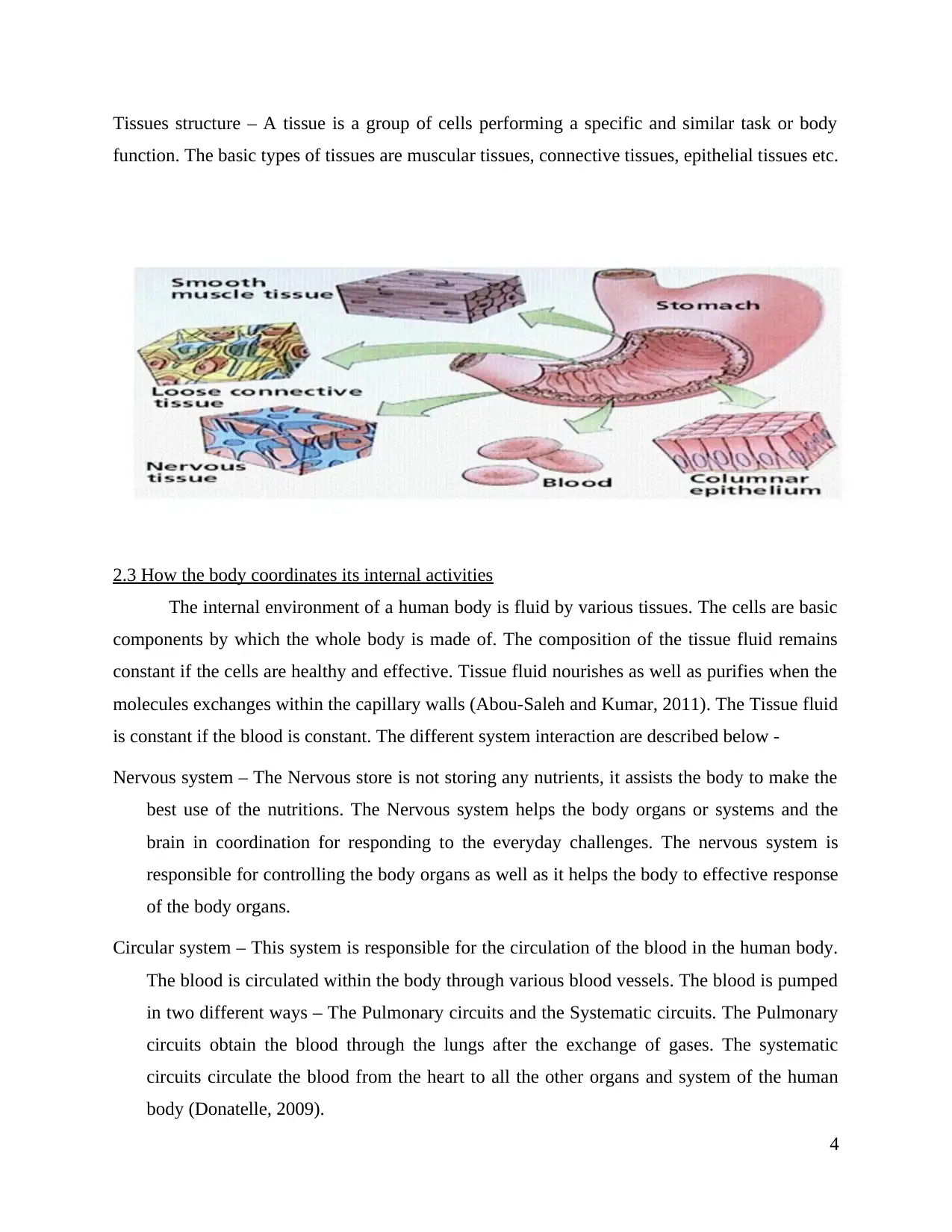
Tissues structure – A tissue is a group of cells performing a specific and similar task or body
function. The basic types of tissues are muscular tissues, connective tissues, epithelial tissues etc.
2.3 How the body coordinates its internal activities
The internal environment of a human body is fluid by various tissues. The cells are basic
components by which the whole body is made of. The composition of the tissue fluid remains
constant if the cells are healthy and effective. Tissue fluid nourishes as well as purifies when the
molecules exchanges within the capillary walls (Abou-Saleh and Kumar, 2011). The Tissue fluid
is constant if the blood is constant. The different system interaction are described below -
Nervous system – The Nervous store is not storing any nutrients, it assists the body to make the
best use of the nutritions. The Nervous system helps the body organs or systems and the
brain in coordination for responding to the everyday challenges. The nervous system is
responsible for controlling the body organs as well as it helps the body to effective response
of the body organs.
Circular system – This system is responsible for the circulation of the blood in the human body.
The blood is circulated within the body through various blood vessels. The blood is pumped
in two different ways – The Pulmonary circuits and the Systematic circuits. The Pulmonary
circuits obtain the blood through the lungs after the exchange of gases. The systematic
circuits circulate the blood from the heart to all the other organs and system of the human
body (Donatelle, 2009).
4
Illustration 2: Types of tissues
function. The basic types of tissues are muscular tissues, connective tissues, epithelial tissues etc.
2.3 How the body coordinates its internal activities
The internal environment of a human body is fluid by various tissues. The cells are basic
components by which the whole body is made of. The composition of the tissue fluid remains
constant if the cells are healthy and effective. Tissue fluid nourishes as well as purifies when the
molecules exchanges within the capillary walls (Abou-Saleh and Kumar, 2011). The Tissue fluid
is constant if the blood is constant. The different system interaction are described below -
Nervous system – The Nervous store is not storing any nutrients, it assists the body to make the
best use of the nutritions. The Nervous system helps the body organs or systems and the
brain in coordination for responding to the everyday challenges. The nervous system is
responsible for controlling the body organs as well as it helps the body to effective response
of the body organs.
Circular system – This system is responsible for the circulation of the blood in the human body.
The blood is circulated within the body through various blood vessels. The blood is pumped
in two different ways – The Pulmonary circuits and the Systematic circuits. The Pulmonary
circuits obtain the blood through the lungs after the exchange of gases. The systematic
circuits circulate the blood from the heart to all the other organs and system of the human
body (Donatelle, 2009).
4
Illustration 2: Types of tissues
⊘ This is a preview!⊘
Do you want full access?
Subscribe today to unlock all pages.

Trusted by 1+ million students worldwide
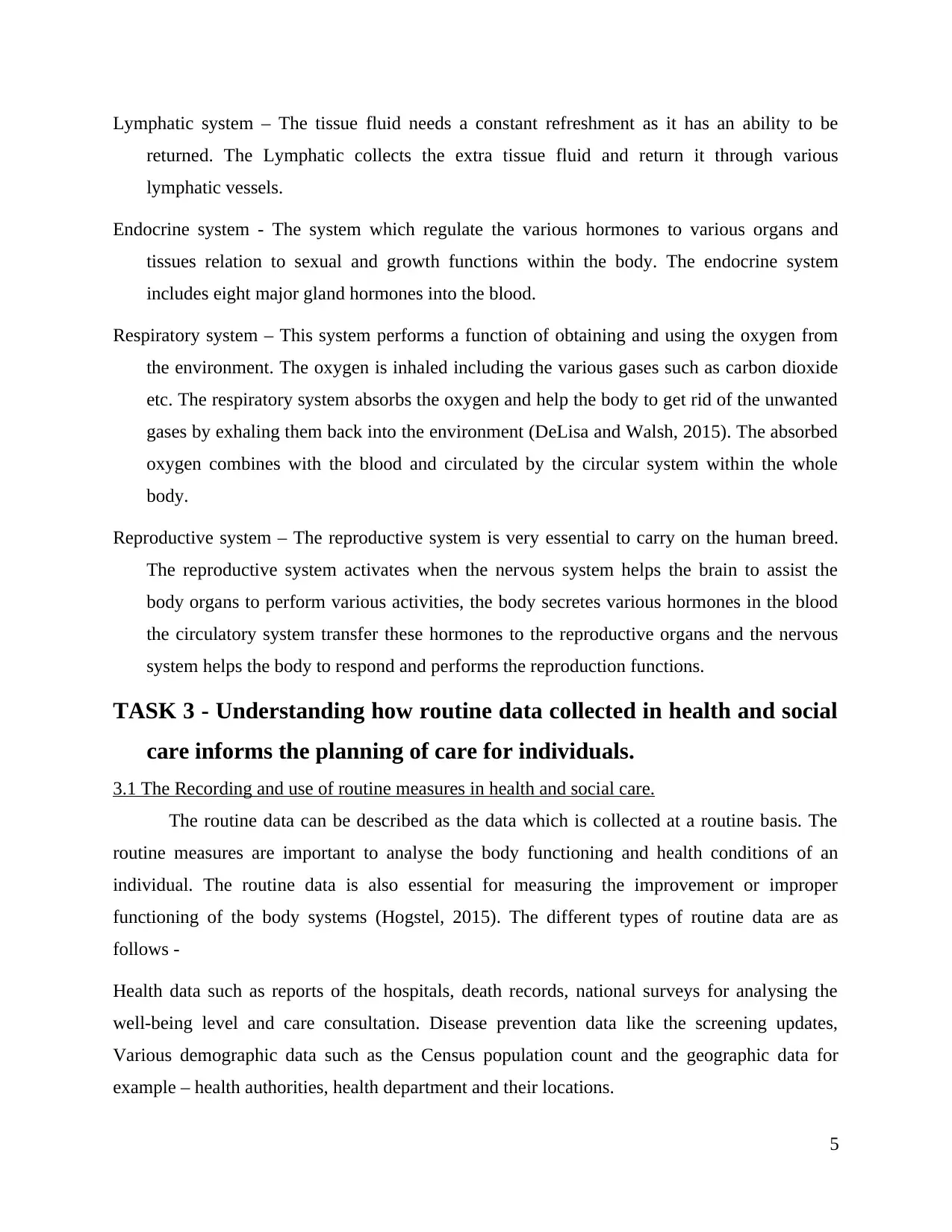
Lymphatic system – The tissue fluid needs a constant refreshment as it has an ability to be
returned. The Lymphatic collects the extra tissue fluid and return it through various
lymphatic vessels.
Endocrine system - The system which regulate the various hormones to various organs and
tissues relation to sexual and growth functions within the body. The endocrine system
includes eight major gland hormones into the blood.
Respiratory system – This system performs a function of obtaining and using the oxygen from
the environment. The oxygen is inhaled including the various gases such as carbon dioxide
etc. The respiratory system absorbs the oxygen and help the body to get rid of the unwanted
gases by exhaling them back into the environment (DeLisa and Walsh, 2015). The absorbed
oxygen combines with the blood and circulated by the circular system within the whole
body.
Reproductive system – The reproductive system is very essential to carry on the human breed.
The reproductive system activates when the nervous system helps the brain to assist the
body organs to perform various activities, the body secretes various hormones in the blood
the circulatory system transfer these hormones to the reproductive organs and the nervous
system helps the body to respond and performs the reproduction functions.
TASK 3 - Understanding how routine data collected in health and social
care informs the planning of care for individuals.
3.1 The Recording and use of routine measures in health and social care.
The routine data can be described as the data which is collected at a routine basis. The
routine measures are important to analyse the body functioning and health conditions of an
individual. The routine data is also essential for measuring the improvement or improper
functioning of the body systems (Hogstel, 2015). The different types of routine data are as
follows -
Health data such as reports of the hospitals, death records, national surveys for analysing the
well-being level and care consultation. Disease prevention data like the screening updates,
Various demographic data such as the Census population count and the geographic data for
example – health authorities, health department and their locations.
5
returned. The Lymphatic collects the extra tissue fluid and return it through various
lymphatic vessels.
Endocrine system - The system which regulate the various hormones to various organs and
tissues relation to sexual and growth functions within the body. The endocrine system
includes eight major gland hormones into the blood.
Respiratory system – This system performs a function of obtaining and using the oxygen from
the environment. The oxygen is inhaled including the various gases such as carbon dioxide
etc. The respiratory system absorbs the oxygen and help the body to get rid of the unwanted
gases by exhaling them back into the environment (DeLisa and Walsh, 2015). The absorbed
oxygen combines with the blood and circulated by the circular system within the whole
body.
Reproductive system – The reproductive system is very essential to carry on the human breed.
The reproductive system activates when the nervous system helps the brain to assist the
body organs to perform various activities, the body secretes various hormones in the blood
the circulatory system transfer these hormones to the reproductive organs and the nervous
system helps the body to respond and performs the reproduction functions.
TASK 3 - Understanding how routine data collected in health and social
care informs the planning of care for individuals.
3.1 The Recording and use of routine measures in health and social care.
The routine data can be described as the data which is collected at a routine basis. The
routine measures are important to analyse the body functioning and health conditions of an
individual. The routine data is also essential for measuring the improvement or improper
functioning of the body systems (Hogstel, 2015). The different types of routine data are as
follows -
Health data such as reports of the hospitals, death records, national surveys for analysing the
well-being level and care consultation. Disease prevention data like the screening updates,
Various demographic data such as the Census population count and the geographic data for
example – health authorities, health department and their locations.
5
Paraphrase This Document
Need a fresh take? Get an instant paraphrase of this document with our AI Paraphraser
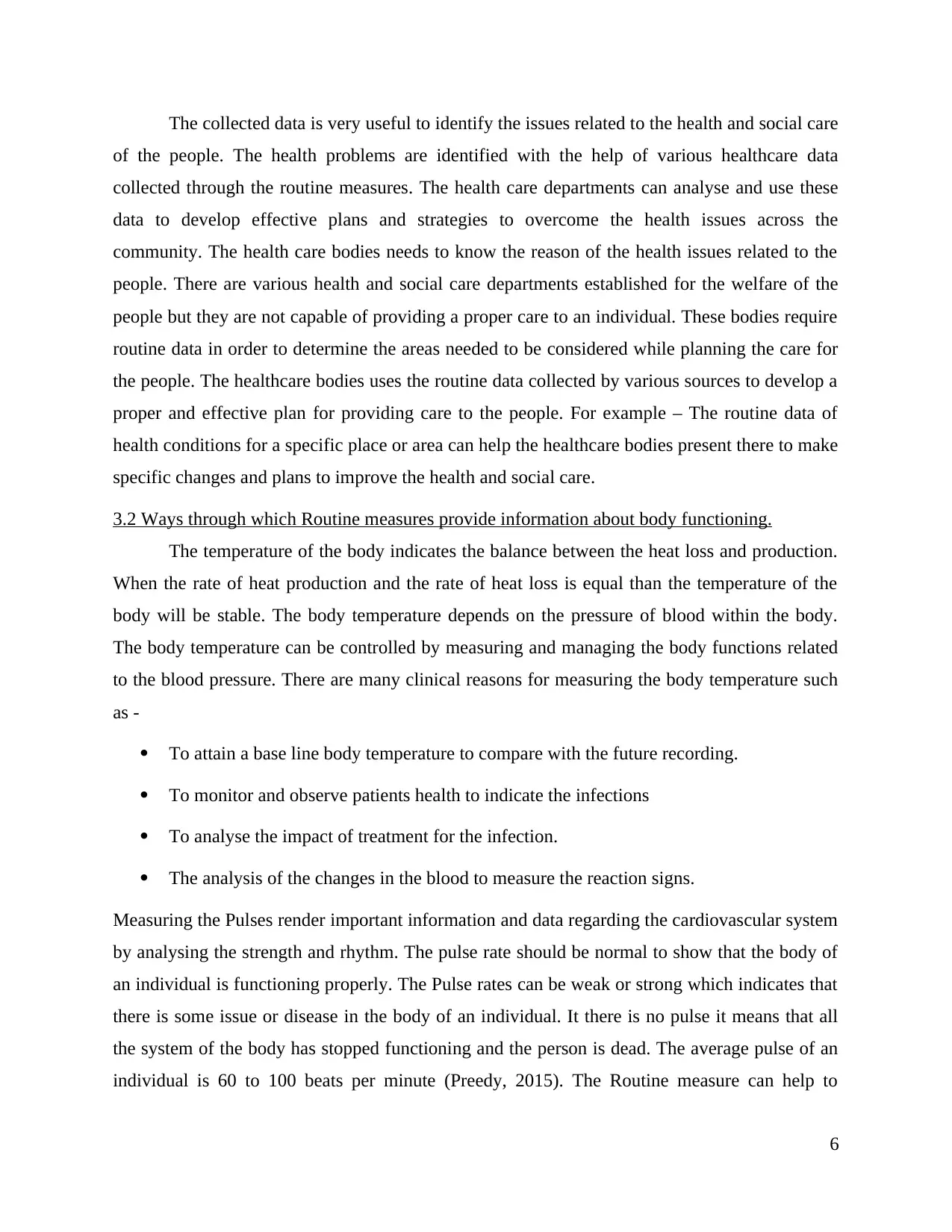
The collected data is very useful to identify the issues related to the health and social care
of the people. The health problems are identified with the help of various healthcare data
collected through the routine measures. The health care departments can analyse and use these
data to develop effective plans and strategies to overcome the health issues across the
community. The health care bodies needs to know the reason of the health issues related to the
people. There are various health and social care departments established for the welfare of the
people but they are not capable of providing a proper care to an individual. These bodies require
routine data in order to determine the areas needed to be considered while planning the care for
the people. The healthcare bodies uses the routine data collected by various sources to develop a
proper and effective plan for providing care to the people. For example – The routine data of
health conditions for a specific place or area can help the healthcare bodies present there to make
specific changes and plans to improve the health and social care.
3.2 Ways through which Routine measures provide information about body functioning.
The temperature of the body indicates the balance between the heat loss and production.
When the rate of heat production and the rate of heat loss is equal than the temperature of the
body will be stable. The body temperature depends on the pressure of blood within the body.
The body temperature can be controlled by measuring and managing the body functions related
to the blood pressure. There are many clinical reasons for measuring the body temperature such
as -
To attain a base line body temperature to compare with the future recording.
To monitor and observe patients health to indicate the infections
To analyse the impact of treatment for the infection.
The analysis of the changes in the blood to measure the reaction signs.
Measuring the Pulses render important information and data regarding the cardiovascular system
by analysing the strength and rhythm. The pulse rate should be normal to show that the body of
an individual is functioning properly. The Pulse rates can be weak or strong which indicates that
there is some issue or disease in the body of an individual. It there is no pulse it means that all
the system of the body has stopped functioning and the person is dead. The average pulse of an
individual is 60 to 100 beats per minute (Preedy, 2015). The Routine measure can help to
6
of the people. The health problems are identified with the help of various healthcare data
collected through the routine measures. The health care departments can analyse and use these
data to develop effective plans and strategies to overcome the health issues across the
community. The health care bodies needs to know the reason of the health issues related to the
people. There are various health and social care departments established for the welfare of the
people but they are not capable of providing a proper care to an individual. These bodies require
routine data in order to determine the areas needed to be considered while planning the care for
the people. The healthcare bodies uses the routine data collected by various sources to develop a
proper and effective plan for providing care to the people. For example – The routine data of
health conditions for a specific place or area can help the healthcare bodies present there to make
specific changes and plans to improve the health and social care.
3.2 Ways through which Routine measures provide information about body functioning.
The temperature of the body indicates the balance between the heat loss and production.
When the rate of heat production and the rate of heat loss is equal than the temperature of the
body will be stable. The body temperature depends on the pressure of blood within the body.
The body temperature can be controlled by measuring and managing the body functions related
to the blood pressure. There are many clinical reasons for measuring the body temperature such
as -
To attain a base line body temperature to compare with the future recording.
To monitor and observe patients health to indicate the infections
To analyse the impact of treatment for the infection.
The analysis of the changes in the blood to measure the reaction signs.
Measuring the Pulses render important information and data regarding the cardiovascular system
by analysing the strength and rhythm. The pulse rate should be normal to show that the body of
an individual is functioning properly. The Pulse rates can be weak or strong which indicates that
there is some issue or disease in the body of an individual. It there is no pulse it means that all
the system of the body has stopped functioning and the person is dead. The average pulse of an
individual is 60 to 100 beats per minute (Preedy, 2015). The Routine measure can help to
6
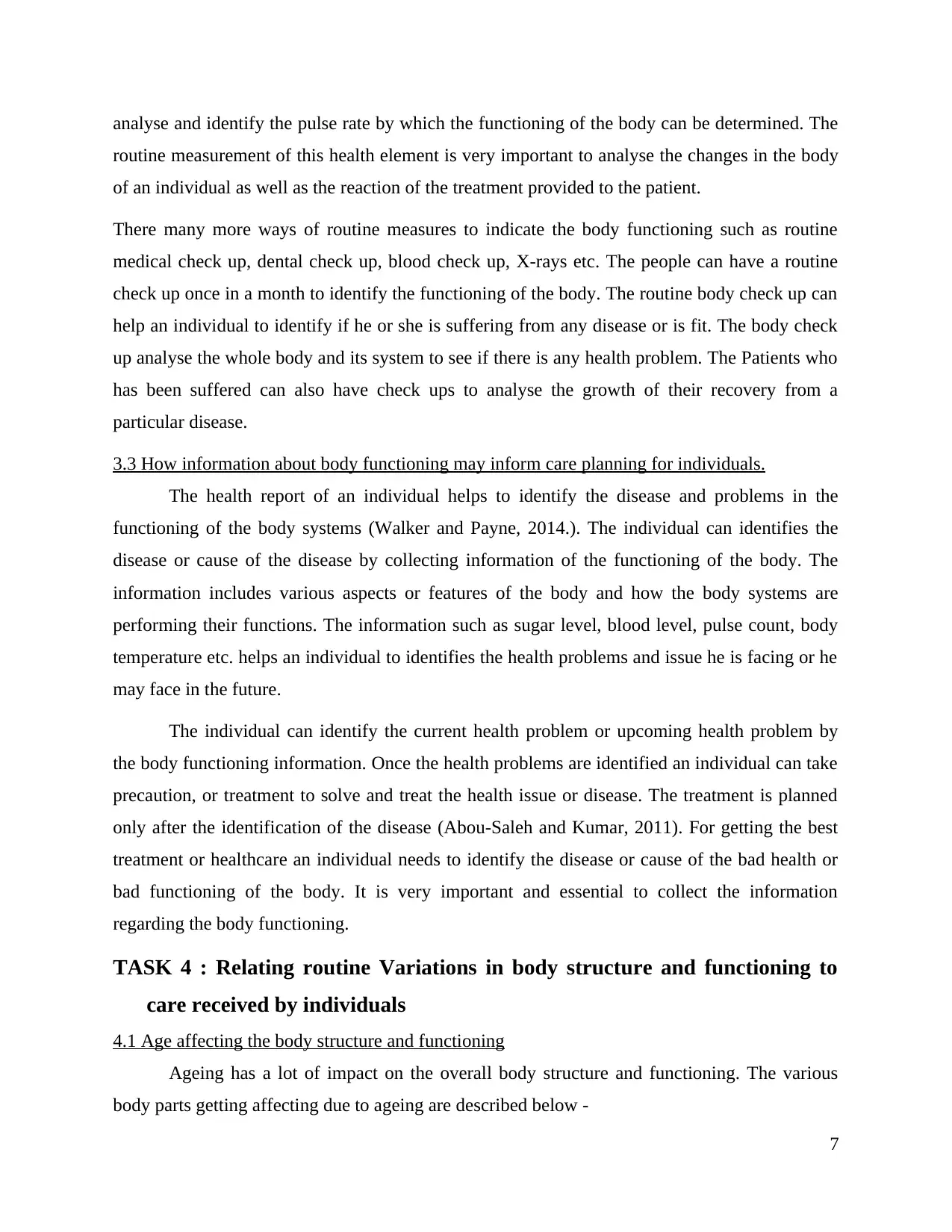
analyse and identify the pulse rate by which the functioning of the body can be determined. The
routine measurement of this health element is very important to analyse the changes in the body
of an individual as well as the reaction of the treatment provided to the patient.
There many more ways of routine measures to indicate the body functioning such as routine
medical check up, dental check up, blood check up, X-rays etc. The people can have a routine
check up once in a month to identify the functioning of the body. The routine body check up can
help an individual to identify if he or she is suffering from any disease or is fit. The body check
up analyse the whole body and its system to see if there is any health problem. The Patients who
has been suffered can also have check ups to analyse the growth of their recovery from a
particular disease.
3.3 How information about body functioning may inform care planning for individuals.
The health report of an individual helps to identify the disease and problems in the
functioning of the body systems (Walker and Payne, 2014.). The individual can identifies the
disease or cause of the disease by collecting information of the functioning of the body. The
information includes various aspects or features of the body and how the body systems are
performing their functions. The information such as sugar level, blood level, pulse count, body
temperature etc. helps an individual to identifies the health problems and issue he is facing or he
may face in the future.
The individual can identify the current health problem or upcoming health problem by
the body functioning information. Once the health problems are identified an individual can take
precaution, or treatment to solve and treat the health issue or disease. The treatment is planned
only after the identification of the disease (Abou-Saleh and Kumar, 2011). For getting the best
treatment or healthcare an individual needs to identify the disease or cause of the bad health or
bad functioning of the body. It is very important and essential to collect the information
regarding the body functioning.
TASK 4 : Relating routine Variations in body structure and functioning to
care received by individuals
4.1 Age affecting the body structure and functioning
Ageing has a lot of impact on the overall body structure and functioning. The various
body parts getting affecting due to ageing are described below -
7
routine measurement of this health element is very important to analyse the changes in the body
of an individual as well as the reaction of the treatment provided to the patient.
There many more ways of routine measures to indicate the body functioning such as routine
medical check up, dental check up, blood check up, X-rays etc. The people can have a routine
check up once in a month to identify the functioning of the body. The routine body check up can
help an individual to identify if he or she is suffering from any disease or is fit. The body check
up analyse the whole body and its system to see if there is any health problem. The Patients who
has been suffered can also have check ups to analyse the growth of their recovery from a
particular disease.
3.3 How information about body functioning may inform care planning for individuals.
The health report of an individual helps to identify the disease and problems in the
functioning of the body systems (Walker and Payne, 2014.). The individual can identifies the
disease or cause of the disease by collecting information of the functioning of the body. The
information includes various aspects or features of the body and how the body systems are
performing their functions. The information such as sugar level, blood level, pulse count, body
temperature etc. helps an individual to identifies the health problems and issue he is facing or he
may face in the future.
The individual can identify the current health problem or upcoming health problem by
the body functioning information. Once the health problems are identified an individual can take
precaution, or treatment to solve and treat the health issue or disease. The treatment is planned
only after the identification of the disease (Abou-Saleh and Kumar, 2011). For getting the best
treatment or healthcare an individual needs to identify the disease or cause of the bad health or
bad functioning of the body. It is very important and essential to collect the information
regarding the body functioning.
TASK 4 : Relating routine Variations in body structure and functioning to
care received by individuals
4.1 Age affecting the body structure and functioning
Ageing has a lot of impact on the overall body structure and functioning. The various
body parts getting affecting due to ageing are described below -
7
⊘ This is a preview!⊘
Do you want full access?
Subscribe today to unlock all pages.

Trusted by 1+ million students worldwide
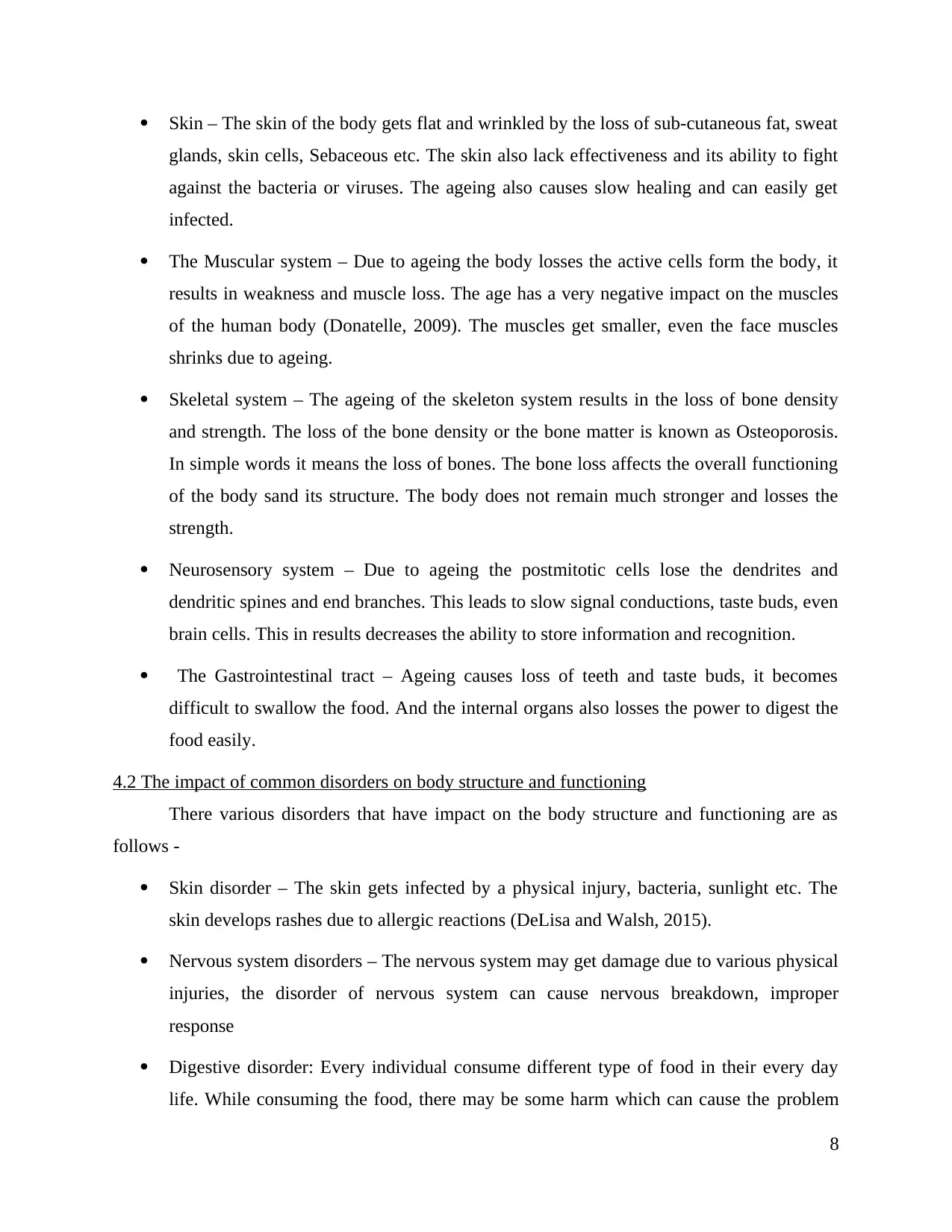
Skin – The skin of the body gets flat and wrinkled by the loss of sub-cutaneous fat, sweat
glands, skin cells, Sebaceous etc. The skin also lack effectiveness and its ability to fight
against the bacteria or viruses. The ageing also causes slow healing and can easily get
infected.
The Muscular system – Due to ageing the body losses the active cells form the body, it
results in weakness and muscle loss. The age has a very negative impact on the muscles
of the human body (Donatelle, 2009). The muscles get smaller, even the face muscles
shrinks due to ageing.
Skeletal system – The ageing of the skeleton system results in the loss of bone density
and strength. The loss of the bone density or the bone matter is known as Osteoporosis.
In simple words it means the loss of bones. The bone loss affects the overall functioning
of the body sand its structure. The body does not remain much stronger and losses the
strength.
Neurosensory system – Due to ageing the postmitotic cells lose the dendrites and
dendritic spines and end branches. This leads to slow signal conductions, taste buds, even
brain cells. This in results decreases the ability to store information and recognition.
The Gastrointestinal tract – Ageing causes loss of teeth and taste buds, it becomes
difficult to swallow the food. And the internal organs also losses the power to digest the
food easily.
4.2 The impact of common disorders on body structure and functioning
There various disorders that have impact on the body structure and functioning are as
follows -
Skin disorder – The skin gets infected by a physical injury, bacteria, sunlight etc. The
skin develops rashes due to allergic reactions (DeLisa and Walsh, 2015).
Nervous system disorders – The nervous system may get damage due to various physical
injuries, the disorder of nervous system can cause nervous breakdown, improper
response
Digestive disorder: Every individual consume different type of food in their every day
life. While consuming the food, there may be some harm which can cause the problem
8
glands, skin cells, Sebaceous etc. The skin also lack effectiveness and its ability to fight
against the bacteria or viruses. The ageing also causes slow healing and can easily get
infected.
The Muscular system – Due to ageing the body losses the active cells form the body, it
results in weakness and muscle loss. The age has a very negative impact on the muscles
of the human body (Donatelle, 2009). The muscles get smaller, even the face muscles
shrinks due to ageing.
Skeletal system – The ageing of the skeleton system results in the loss of bone density
and strength. The loss of the bone density or the bone matter is known as Osteoporosis.
In simple words it means the loss of bones. The bone loss affects the overall functioning
of the body sand its structure. The body does not remain much stronger and losses the
strength.
Neurosensory system – Due to ageing the postmitotic cells lose the dendrites and
dendritic spines and end branches. This leads to slow signal conductions, taste buds, even
brain cells. This in results decreases the ability to store information and recognition.
The Gastrointestinal tract – Ageing causes loss of teeth and taste buds, it becomes
difficult to swallow the food. And the internal organs also losses the power to digest the
food easily.
4.2 The impact of common disorders on body structure and functioning
There various disorders that have impact on the body structure and functioning are as
follows -
Skin disorder – The skin gets infected by a physical injury, bacteria, sunlight etc. The
skin develops rashes due to allergic reactions (DeLisa and Walsh, 2015).
Nervous system disorders – The nervous system may get damage due to various physical
injuries, the disorder of nervous system can cause nervous breakdown, improper
response
Digestive disorder: Every individual consume different type of food in their every day
life. While consuming the food, there may be some harm which can cause the problem
8
Paraphrase This Document
Need a fresh take? Get an instant paraphrase of this document with our AI Paraphraser
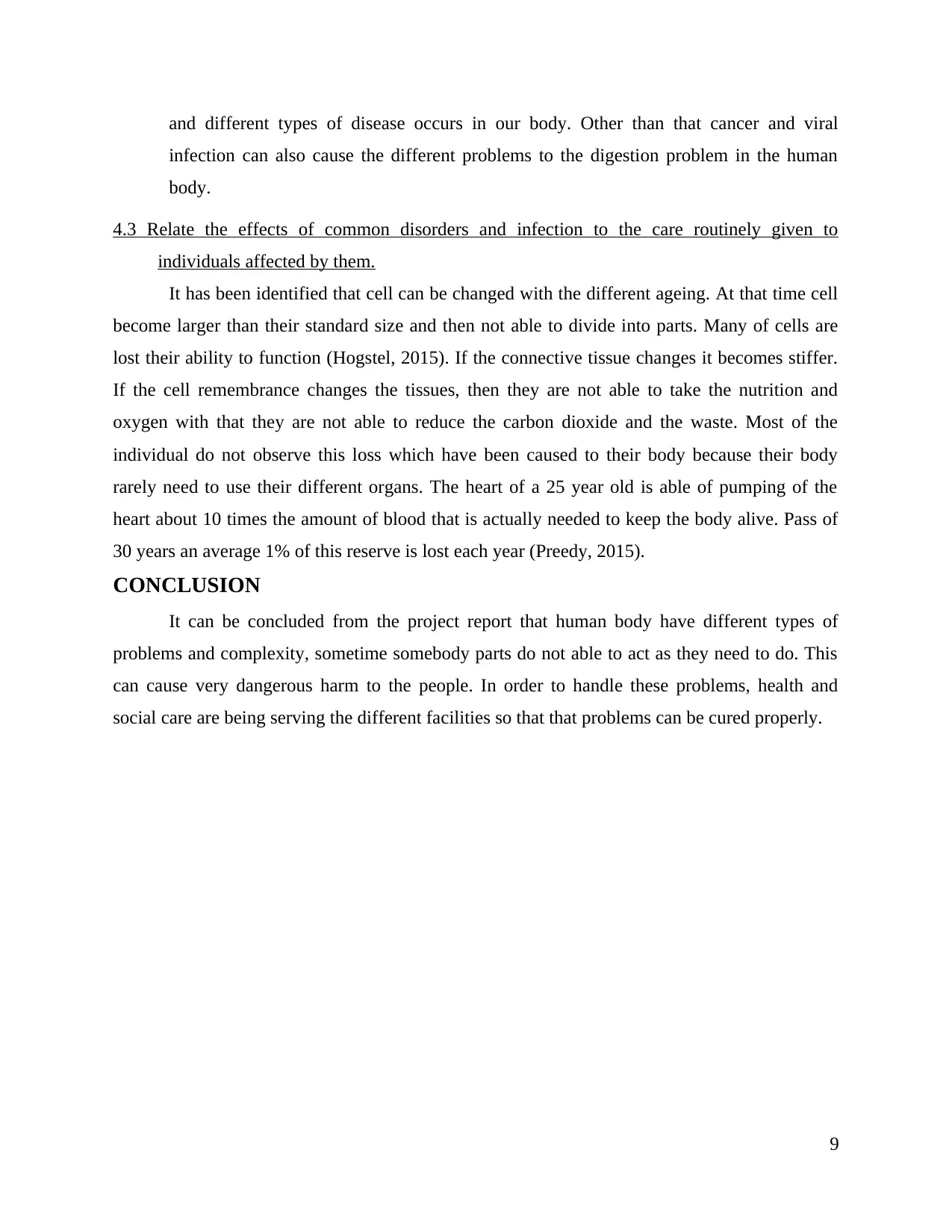
and different types of disease occurs in our body. Other than that cancer and viral
infection can also cause the different problems to the digestion problem in the human
body.
4.3 Relate the effects of common disorders and infection to the care routinely given to
individuals affected by them.
It has been identified that cell can be changed with the different ageing. At that time cell
become larger than their standard size and then not able to divide into parts. Many of cells are
lost their ability to function (Hogstel, 2015). If the connective tissue changes it becomes stiffer.
If the cell remembrance changes the tissues, then they are not able to take the nutrition and
oxygen with that they are not able to reduce the carbon dioxide and the waste. Most of the
individual do not observe this loss which have been caused to their body because their body
rarely need to use their different organs. The heart of a 25 year old is able of pumping of the
heart about 10 times the amount of blood that is actually needed to keep the body alive. Pass of
30 years an average 1% of this reserve is lost each year (Preedy, 2015).
CONCLUSION
It can be concluded from the project report that human body have different types of
problems and complexity, sometime somebody parts do not able to act as they need to do. This
can cause very dangerous harm to the people. In order to handle these problems, health and
social care are being serving the different facilities so that that problems can be cured properly.
9
infection can also cause the different problems to the digestion problem in the human
body.
4.3 Relate the effects of common disorders and infection to the care routinely given to
individuals affected by them.
It has been identified that cell can be changed with the different ageing. At that time cell
become larger than their standard size and then not able to divide into parts. Many of cells are
lost their ability to function (Hogstel, 2015). If the connective tissue changes it becomes stiffer.
If the cell remembrance changes the tissues, then they are not able to take the nutrition and
oxygen with that they are not able to reduce the carbon dioxide and the waste. Most of the
individual do not observe this loss which have been caused to their body because their body
rarely need to use their different organs. The heart of a 25 year old is able of pumping of the
heart about 10 times the amount of blood that is actually needed to keep the body alive. Pass of
30 years an average 1% of this reserve is lost each year (Preedy, 2015).
CONCLUSION
It can be concluded from the project report that human body have different types of
problems and complexity, sometime somebody parts do not able to act as they need to do. This
can cause very dangerous harm to the people. In order to handle these problems, health and
social care are being serving the different facilities so that that problems can be cured properly.
9
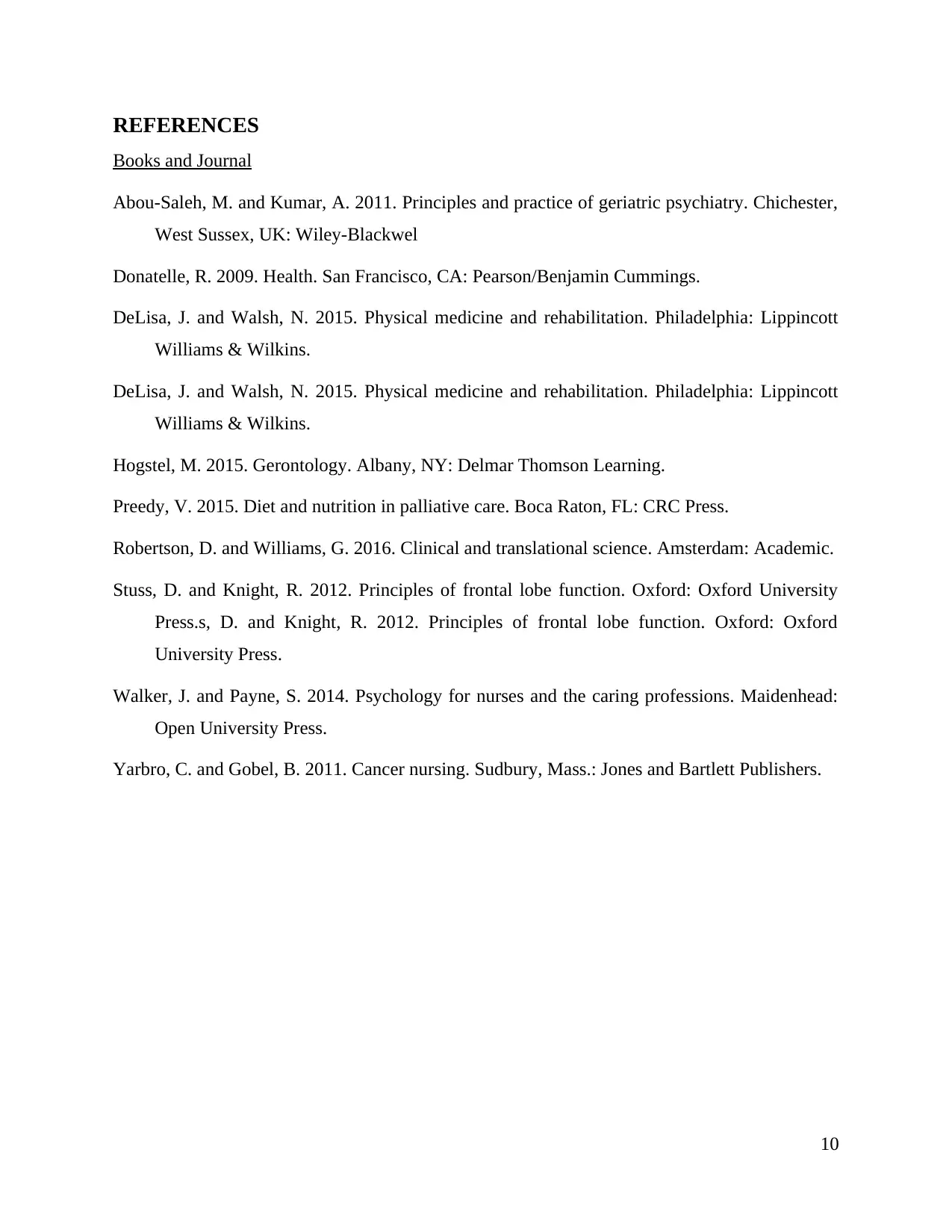
REFERENCES
Books and Journal
Abou-Saleh, M. and Kumar, A. 2011. Principles and practice of geriatric psychiatry. Chichester,
West Sussex, UK: Wiley-Blackwel
Donatelle, R. 2009. Health. San Francisco, CA: Pearson/Benjamin Cummings.
DeLisa, J. and Walsh, N. 2015. Physical medicine and rehabilitation. Philadelphia: Lippincott
Williams & Wilkins.
DeLisa, J. and Walsh, N. 2015. Physical medicine and rehabilitation. Philadelphia: Lippincott
Williams & Wilkins.
Hogstel, M. 2015. Gerontology. Albany, NY: Delmar Thomson Learning.
Preedy, V. 2015. Diet and nutrition in palliative care. Boca Raton, FL: CRC Press.
Robertson, D. and Williams, G. 2016. Clinical and translational science. Amsterdam: Academic.
Stuss, D. and Knight, R. 2012. Principles of frontal lobe function. Oxford: Oxford University
Press.s, D. and Knight, R. 2012. Principles of frontal lobe function. Oxford: Oxford
University Press.
Walker, J. and Payne, S. 2014. Psychology for nurses and the caring professions. Maidenhead:
Open University Press.
Yarbro, C. and Gobel, B. 2011. Cancer nursing. Sudbury, Mass.: Jones and Bartlett Publishers.
10
Books and Journal
Abou-Saleh, M. and Kumar, A. 2011. Principles and practice of geriatric psychiatry. Chichester,
West Sussex, UK: Wiley-Blackwel
Donatelle, R. 2009. Health. San Francisco, CA: Pearson/Benjamin Cummings.
DeLisa, J. and Walsh, N. 2015. Physical medicine and rehabilitation. Philadelphia: Lippincott
Williams & Wilkins.
DeLisa, J. and Walsh, N. 2015. Physical medicine and rehabilitation. Philadelphia: Lippincott
Williams & Wilkins.
Hogstel, M. 2015. Gerontology. Albany, NY: Delmar Thomson Learning.
Preedy, V. 2015. Diet and nutrition in palliative care. Boca Raton, FL: CRC Press.
Robertson, D. and Williams, G. 2016. Clinical and translational science. Amsterdam: Academic.
Stuss, D. and Knight, R. 2012. Principles of frontal lobe function. Oxford: Oxford University
Press.s, D. and Knight, R. 2012. Principles of frontal lobe function. Oxford: Oxford
University Press.
Walker, J. and Payne, S. 2014. Psychology for nurses and the caring professions. Maidenhead:
Open University Press.
Yarbro, C. and Gobel, B. 2011. Cancer nursing. Sudbury, Mass.: Jones and Bartlett Publishers.
10
⊘ This is a preview!⊘
Do you want full access?
Subscribe today to unlock all pages.

Trusted by 1+ million students worldwide
1 out of 12
Related Documents
Your All-in-One AI-Powered Toolkit for Academic Success.
+13062052269
info@desklib.com
Available 24*7 on WhatsApp / Email
![[object Object]](/_next/static/media/star-bottom.7253800d.svg)
Unlock your academic potential
Copyright © 2020–2025 A2Z Services. All Rights Reserved. Developed and managed by ZUCOL.





